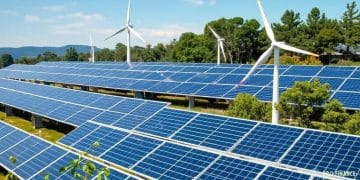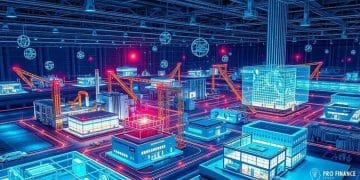The role of AI in autonomous drones for agriculture
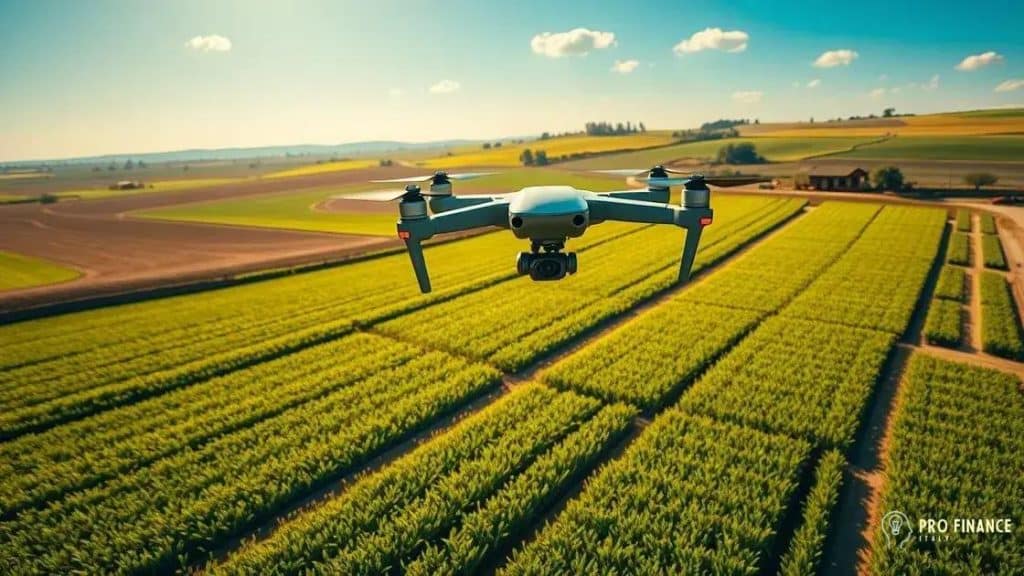
The role of AI in autonomous drones for agriculture enhances productivity and efficiency by enabling precise crop monitoring, optimizing resource use, and promoting sustainable farming practices.
The role of AI in autonomous drones for agriculture is reshaping the future of farming. As these technologies advance, have you considered how they might enhance crop management and efficiency? Let’s dive in.
Understanding the technology behind autonomous drones
Understanding the technology behind autonomous drones is essential to appreciate their impact on modern agriculture. These machines utilize advanced systems to operate independently, making them invaluable for farmers.
At the core of autonomous drones is a combination of artificial intelligence, sensors, and GPS technology. These components work together to gather data and perform tasks without the need for human intervention.
Key Technologies Involved
Several key technologies enable the functionality of autonomous drones:
- AI Algorithms: These algorithms process vast amounts of data, enabling drones to make decisions in real-time.
- GPS Navigation: GPS systems allow drones to fly predetermined paths, ensuring accurate coverage of agricultural fields.
- Camera Systems: High-resolution cameras and sensors collect data on crop health, soil conditions, and environmental factors.
The integration of these technologies not only enhances the efficiency of agricultural practices but also reduces labor costs significantly. Moreover, with continuous advancements in machine learning, the accuracy and capabilities of these drones are set to improve.
As farmers adopt these technologies, they are better equipped to monitor their crops and manage resources. Through data analysis, farmers can identify issues like nutrient deficiencies or pest infestations early on, allowing for timely intervention.
Challenges in Technology Adoption
Despite the advantages, there are challenges in implementing this technology:
- Cost of Equipment: High initial investments can be a barrier for some farmers.
- Technological Knowledge: Understanding how to operate and interpret data from drones requires training.
- Regulatory Issues: Compliance with local aviation regulations can complicate the deployment of these drones.
Overcoming these challenges is crucial for maximizing the potential of autonomous drones in agriculture. As technology continues to evolve, the future holds promising possibilities for farmers who embrace these innovations.
Benefits of AI in agriculture management
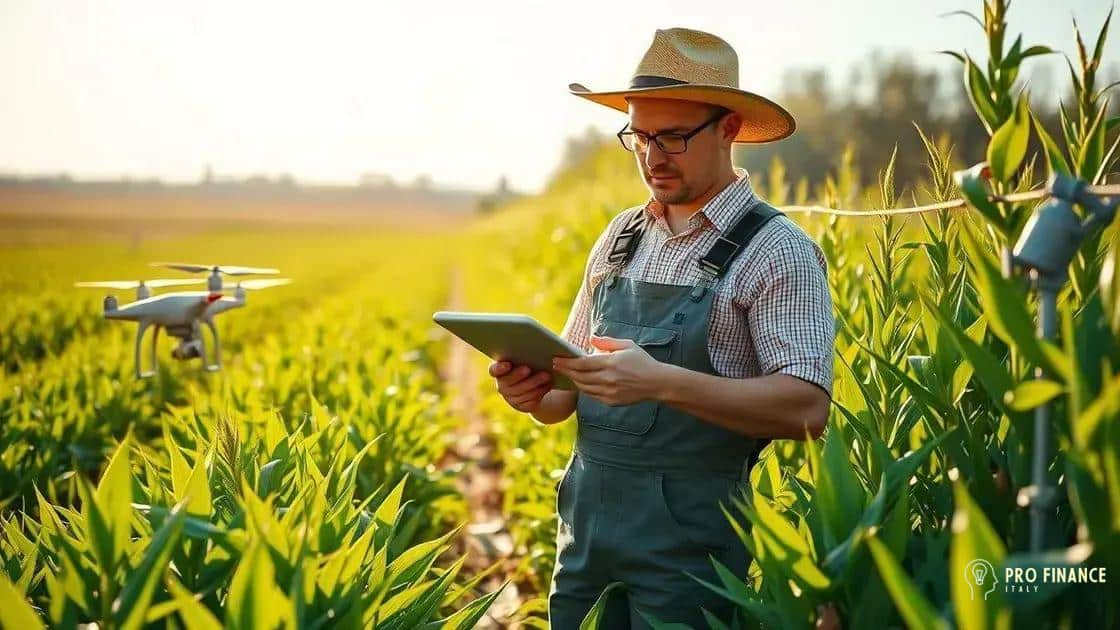
The benefits of AI in agriculture management are significant and far-reaching. Farmers can leverage technology to optimize operations, enhance productivity, and reduce costs.
One of the primary advantages is improved decision-making. With AI-driven data analysis, farmers can gain insights into crop health, weather patterns, and soil conditions. This information helps in planning and managing resources more effectively.
Key Benefits of AI
Here are some key benefits of AI in agriculture management:
- Precision Farming: AI allows for targeted interventions such as precision irrigation and fertilization, leading to better yield.
- Cost Reduction: Automation reduces labor costs and improves the efficiency of farm operations.
- Pest and Disease Management: AI systems can identify pests and diseases early, enabling prompt action to protect crops.
Another benefit of implementing AI is the enhancement of resource management. By analyzing data from various sources, farmers can use water more efficiently and minimize wastage. This optimizes productivity while also supporting sustainability.
Furthermore, AI technologies enable farmers to monitor their fields in real-time. Drones equipped with AI can capture images and data on crop conditions, making it easier to address issues like nutrient deficiencies without delay.
Improved Yield and Sustainability
Ultimately, the integration of AI leads to improved yield and greater sustainability. The ability to make data-driven decisions empowers farmers to adopt practices that increase crop productivity responsibly.
As AI continues to evolve, the agricultural sector is likely to see even more innovations that enhance management practices. Adopting these technologies is crucial for meeting the demands of a growing population while ensuring environmental sustainability.
Real-world applications of drones in farming
Real-world applications of drones in farming are transforming the agricultural landscape. Farmers are using drones to manage their fields more effectively and efficiently.
Drones enable precision agriculture, allowing farmers to monitor crops from above. This helps in identifying problems that may not be visible from the ground. For instance, farmers can detect areas that need more water or fertilizers, leading to better resource management.
Key Applications of Drones
Here are some key applications of drones in farming:
- Crop Monitoring: Drones provide aerial images that help farmers assess plant health and growth.
- Soil Analysis: Drones can map soil moisture levels, aiding in irrigation management.
- Pest Control: Using drones for targeted spraying can minimize pesticide use and reduce costs.
Additionally, drones can facilitate planting. Some models are capable of efficiently dispersing seeds in a specified area, ensuring optimal spacing and coverage. This technology saves time and labor while increasing planting efficiency.
Another valuable application is in mapping and surveying large fields. Drones quickly gather and analyze data, creating detailed maps that can be used for planning and planting strategies. This enhances the overall management of farm operations.
Data Collection and Analysis
The ability to collect and analyze data through drones is invaluable. Farmers can track changes in crop conditions over time, allowing for data-driven decision-making. Moreover, this data can assist with yield prediction, helping farmers plan for harvests.
As drone technology continues to advance, the possibilities for its applications in farming will expand. Embracing these innovations can lead to improved productivity and sustainability in agriculture.
Challenges in integrating AI and drone technology
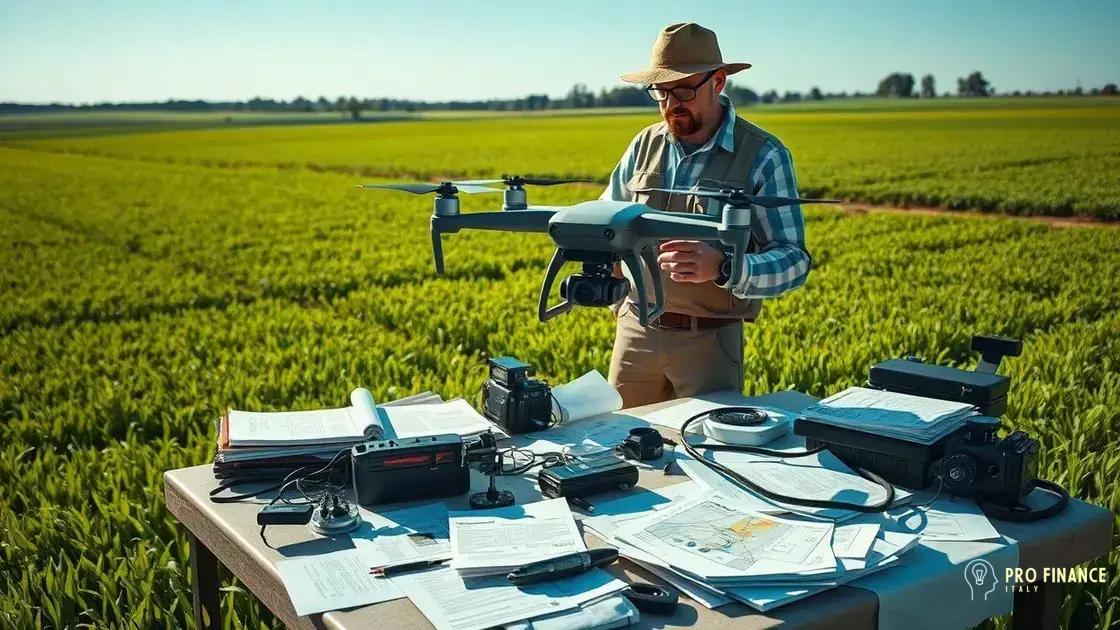
Challenges in integrating AI and drone technology in agriculture can pose significant hurdles for farmers. Despite the advantages, several factors can complicate the adoption of these technologies.
One major challenge is the high cost of equipment. Drones equipped with advanced AI capabilities can be expensive to purchase and maintain. Farmers may struggle to justify these costs, especially in smaller operations with limited budgets.
Technical Knowledge and Training
Another critical issue is the need for technical knowledge. Farmers must understand how to operate drones and interpret the data they collect. Training is essential, but access to resources and knowledge can be limited.
- Industry-Specific Knowledge: Integrating AI requires a deep understanding of both agriculture and technology.
- Ongoing Training: As technology evolves, continuous education is necessary to keep up with new features and updates.
- Data Handling: Farmers need skills to analyze the data collected and turn it into actionable insights.
Moreover, regulatory issues can create barriers to utilizing drone technology. Different countries have varied regulations regarding drone use, including altitude limits and no-fly zones. These regulations can hinder farmers’ ability to fully exploit the capabilities of their drones.
Potential Solutions
To overcome these challenges, it is essential for farmers to seek partnerships with technology providers and educational institutions. Collaborations can help farmers access training programs and financial assistance, enabling them to integrate AI and drones into their operations more effectively.
Additionally, participating in workshops and agricultural technology seminars can provide farmers with the necessary insights and skills. Understanding the regulations and staying informed about industry developments is crucial for successfully leveraging these technologies.
Future trends in agricultural drone technology
Future trends in agricultural drone technology are set to reshape how farming is conducted around the world. As technology advances, farmers can expect drones to become even more integrated into daily operations.
One major trend is the enhancement of AI algorithms. These improvements will allow drones to perform more complex tasks, such as real-time crop monitoring and predictive analytics. Farmers will be able to receive alerts about crop health issues before they become significant problems.
Emerging Technologies
Some emerging technologies to watch include:
- Increased Automation: Future drones will likely feature even higher levels of automation, requiring less human intervention.
- Advanced Sensors: New sensors will provide more detailed information on soil health, moisture levels, and crop growth stages.
- Integration with IoT: Drones will increasingly connect with Internet of Things (IoT) devices, enabling seamless data sharing and communication.
Moreover, the use of drones for data collection will expand. With the ability to gather and analyze vast amounts of data, farmers can optimize their operations significantly. This leads to better resource management and increased yield.
Another trend is the development of more user-friendly interfaces. As drone technology becomes more accessible, simpler controls will allow farmers with less technical expertise to operate drones effectively.
Environmental Impact
As sustainability becomes a key focus in agriculture, drones will play a vital role in promoting eco-friendly practices. By using drones for precision farming, farmers can minimize chemical use and optimize resource allocation, reducing the environmental footprint of their operations.
Overall, farmers can look forward to a future where drones are indispensable tools in agriculture. Embracing these trends can lead to a more efficient, productive, and sustainable agricultural industry.
In conclusion, the integration of AI and drones in agriculture presents exciting possibilities. These technologies enhance farming practices by improving efficiency and productivity. As we explore future trends, the potential for better resource management and sustainable practices becomes ever clearer. Embracing these advancements can lead to a more robust agricultural industry that meets the needs of a growing population.
FAQ – Questions about AI and Drone Technology in Agriculture
How can drones improve efficiency in farming?
Drones can monitor crop health, apply fertilizers, and manage resources more effectively, leading to higher efficiency and productivity.
What are some future trends in agricultural drone technology?
Future trends include enhanced AI algorithms, increased automation, and advanced sensors for better data collection.
What challenges do farmers face when integrating drone technology?
Challenges include high costs, the need for technical knowledge, and compliance with local regulations.
How can farmers stay updated on drone technology?
Farmers can participate in workshops, collaborate with tech providers, and follow industry news to stay informed about advancements in drone technology.


